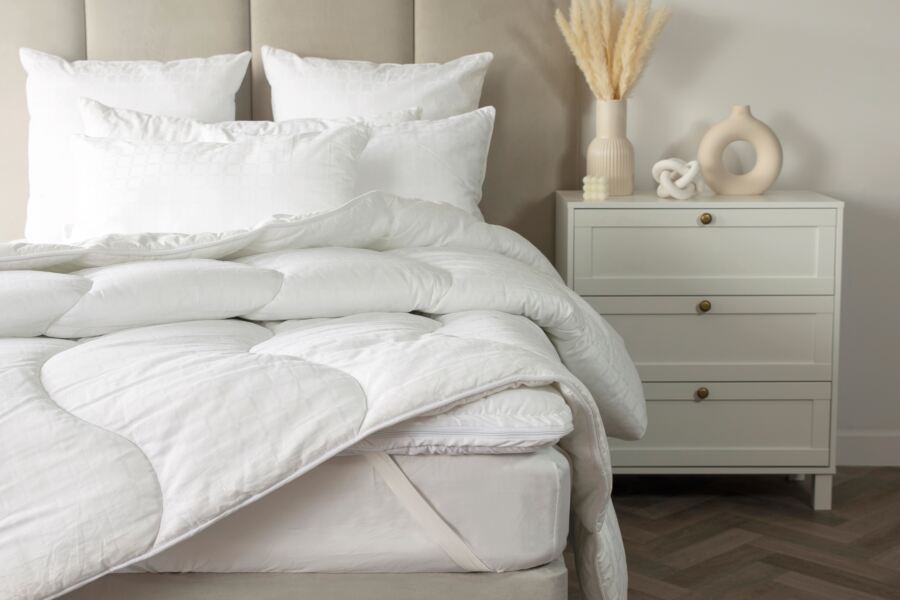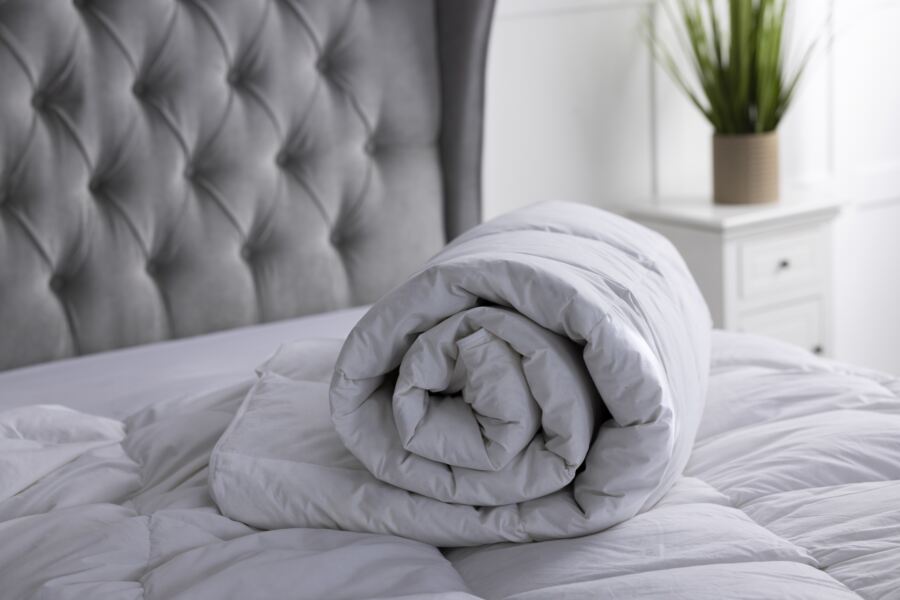Table of Contents
- When To Make The Switch From Your Summer Duvet
- Why You Need To Change Your Duvet For Winter
- Understanding Tog Ratings
- FAQs
- Final Thoughts
As the seasons start to change, it's getting closer and closer to that all-important time of year - the time to switch your bedding for winter. But knowing when to change your duvet from a lightweight summer duvet to a heavier duvet to keep you warm and snug can be tricky. If you do it too early, you may be left awake and sweating. Still, not doing it early enough can leave your teeth chattering.
In this short guide, we'll explore the best time to switch your duvet, as well as why it's important and what you need to know to ensure you get the best night's sleep.

When To Make The Switch From Your Summer Duvet
The most common question that people ask when it comes to season changes is 'When is the right time to switch your duvet?'. Well, there's no exact date to change over to your winter duvet since it actually depends on where you live and the local weather patterns.
However, according to sleep experts, the best time to make the change is when the average daily temperatures are consistently below 15 °C and the nightly average temperature is below 10 °C. As soon as these temperatures stay consistently chilly, it's time to ditch your summer bedding and find winter duvets with the right duvet tog for the temperature.
Waiting for too long to change your lighter duvet can leave you shivering and shaking in bed, which can affect your sleep quality and overall well-being. Still, changing to fleece-lined bed sheets and a winter duvet too soon can make you feel uncomfortably warm. Either way, neither situation is ideal!
It's a delicate balance, and the timing ultimately depends on several important factors...
Room size
The size of your room plays a huge role in signalling when you should switch your duvet. Smaller rooms usually retain heat more efficiently than bigger, more spacious rooms. This means that it's easier to keep them warm during the winter months.
When you have a bigger room, heat is lost more easily, which means they tend to cool down a lot quicker - especially at night! If your room is bigger, you're going to need a thick duvet to stay warm.
Insulation
The amount of insulation in your home can directly impact the temperature inside your bedroom. Generally, well-insulated homes or homes with central heating are much warmer. They also stay warm for longer periods, which means you won't need an extra-thick duvet to keep you warm. In these cases, a thinner duvet with a lower tog rating can still keep you toasty.
Climate
The average temperature in your area can impact your choice of duvet as well. In some areas, the winters are much milder than in others. At the same time, there are certain regions that have more extreme temperature fluctuations and the weather can change at the drop of a hat.
If you live in a naturally cooler climate, then you may need to switch your duvet earlier in the season to make sure that you stay warm at night.
Personal preferences
There are as many types of sleepers as there are different types of bedding, and this is something to consider before you pack your summer duvet away for the winter time. For example, cold sleepers struggle to stay warm at night (even on warmer nights) and will need a thicker duvet - unless they want broken sleep, that is.
However, there are also hot sleepers who can't seem to cool down at night. In that case, the right time to switch out their duvet may come later, sometimes even in the coldest months of the year!

Why You Need To Change Your Duvet For Winter
Changing your summer bedding for the winter months isn't just a matter of comfort - it's actually an essential step to take to ensure that you're getting a good night's sleep on cold nights. Since your duvet plays a role in helping you regulate your body temperature as you sleep, making the switch from a summer to a winter duvet is important for several reasons.
Tog rating
One of the most important factors to consider when you're changing your duvet is the duvet tog rating. The tog rating helps to measure a duvet's thermal resistance, which involves how effectively it can retain heat (more on this later).
During the summer, you want a lower tog summer duvet of around 4.5 tog or less. This will help you beat those dreaded night sweats on warm summer nights. However, as the temperatures start to drop and it gets cooler, a lighter duvet can leave you feeling cold and restless.
On long and chilly nights, you'll want to switch your duvet to a thick autumn/winter duvet with a higher tog rating (usually a 10.5 tog to a 13.5 tog rating). A thicker duvet will help to trap your body heat, keeping you warm and cosy. Of course, this is great for comfort but it's also practical! Using quality cold-weather bedding can help you to save on heating costs.
Duvet material
In addition to the tog rating, you'll want to consider the material of your duvet. This can make a huge difference to how cool or warm you feel.
Natural materials like goose or duck down are a fantastic choice for a winter duvet since they offer ultimate heat retention while still being breathable. For example, a 10.5 tog duck down duvet will leave you feeling snug, while a 13.5 tog duck down duvet is slightly toastier, but is great for cold sleepers.
That's not to say that you need to buy premium material to stay cuddly and cosy during the winter months! In reality, synthetic materials like microfibre work just as well and have a lightweight feel while still giving you the warmth you need. You can also get these materials in a high tog rating, like a 10.5 tog microfibre duvet or a microfibre duvet with a 13.5 tog rating that has a heavier feel.
Understanding Tog Ratings
A tog rating (short for 'thermal overall grade') is a measurement of a duvet's ability to trap and retain heat. Ultimately, it's an indicator of how well your duvet insulates and how warm it will keep you. Generally, tog ratings are rated on a scale from 1 to 15, with the higher numbers being warmer and more insulating.
When you go shopping for new bedding, you'll typically see three categories of tog ratings, including:
-
Low tog rating: This ranges between 1 and 4.5, and the duvets are lightweight and ideal for hot sleepers.
-
Medium tog rating: A medium tog rating (7.5 - 10.5) may be good for year-round use in areas with a more consistent climate.
-
High tog rating: A high tog rating is anything above 10.5 and offers plenty of warmth for colder weather.
The tog rating you choose will ultimately depend on your preferences and the climate in your area. However, it's always good to know what togs work for which seasons, and which ones you'll need to stay cool or warm depending on the weather.
FAQs
How often should a duvet be replaced?
Ideally, you should change your duvet every few years, but this isn't always the case. If you have a high-quality duvet and care for it properly, it should last for between 5 and 10 years. But, if your duvet is showing signs of wear and tear or clumping, it may be time to swap it out for a new one.
Can you use a 13.5 tog duvet in summer?
A 13.5 tog duvet will probably be too hot for summertime use since these duvets are thicker and trap more heat than lighter duvets. Instead, you may want to look for an all-season duvet with a tog between 7.5 and 10.5, or a lightweight summer duvet with a lower tog rating.
When should I change my summer duvet UK?
No matter where you live, you should always change your duvet according to the temperature fluctuations in your area. However, most regions within the UK start to get cooler in the autumn months, from late September to early October. When the days and nights start to get cooler, it's important to keep an eye on the weather to change your bedding at the right time.
What tog is best for all year round?
The best tog rating for all-season bedding will typically be around 7.5 to 10.5. These duvets are designed for mild weather when it's not too hot or too cold. This makes them a great choice for year-round use, but this will ultimately depend on your sleeping preferences.
Final Thoughts
You don't need to be a bedding expert to spruce up your room and optimise it for the wintertime. Rather, we've gathered all the information you need to know so that you can head into the cooler seasons with confidence and get the sleep quality you deserve. No more cold toes or goosebumps in the middle of the night. Just peaceful, uninterrupted sleep!











